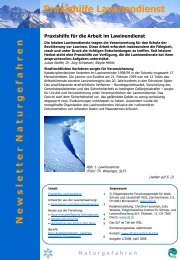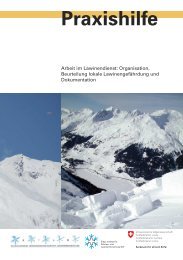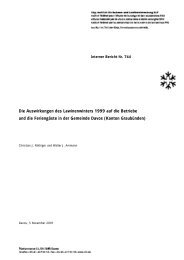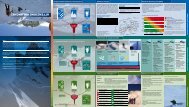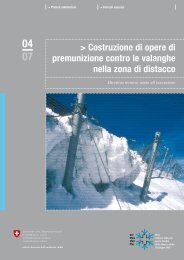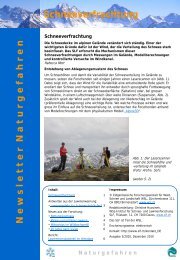97 KJ?E D Å 7 L7 B7 D9 >; I - SLF
97 KJ?E D Å 7 L7 B7 D9 >; I - SLF
97 KJ?E D Å 7 L7 B7 D9 >; I - SLF
Create successful ePaper yourself
Turn your PDF publications into a flip-book with our unique Google optimized e-Paper software.
Edited by:<br />
The «Snow Sport Avalanche Accident Prevention» core training team (www.slf.ch/kat), consisting of: WSL Institute<br />
for Snow and Avalanche Research <strong>SLF</strong>, Davos Swiss Slpine Club (SAC) Federal Office of Sports, Magglingen (BASPO)<br />
Association of Swiss Mountain Guides (ASMG) Swiss Army (Cen exce A mtn tng) Swiss Ski Swiss Snowsports Swiss<br />
Association of Mountaineering Schools (SAMS) Swiss Cableways (SCW) Friends of Nature Switzerland (FNS) Alpine<br />
Rescue Switzerland (ARS) Swiss Council for Accident Prevention (bfu) Suva<br />
With the support of:<br />
MeteoSwiss Swiss Commission for the Prevention of Accidents on Snowsport Runs SKUS Swiss Air Rescue (Rega)<br />
Swiss Foundation for Alpine Research (SFAR) Rescue Organisation of the Canton of Valais (KWRO/OCVS) Swiss<br />
Association of Snowbording Schools (SSBS)<br />
Where to order:<br />
The Editors<br />
Sixth completely revised edition: © 2009<br />
Authors: Stephan Harvey (<strong>SLF</strong>, Editorial) Jürg Schweizer (<strong>SLF</strong>) Hansueli Rhyner (<strong>SLF</strong>) Paul Nigg (Core Training Team<br />
Principal) Bruno Hasler (SAC)<br />
Concept/Graphics: faktorplus und neuweiss communications, Bern<br />
Translation: Levi O‘Neil<br />
<br />
<br />
<br />
Trip with alternatives and schedule<br />
Conditions<br />
Avalanche Situation<br />
(Forecast)<br />
Observations made over the entire day<br />
Conditions<br />
Current avalanche<br />
situation<br />
(Observations)<br />
Collect as much information<br />
as possible regarding<br />
the slope of the key<br />
passage: E.g. Warning<br />
signs, conditions on<br />
similar slopes.<br />
Final risk assessment, trail selection, safety measures, turning<br />
back<br />
Conditions<br />
Avalanche<br />
danger? Visibility?<br />
Do the assumptions<br />
match the reality?<br />
After the tour / descent<br />
Verhältnisse<br />
Terrain<br />
Map / Key<br />
Passages<br />
Decision<br />
Which tour is<br />
feasible?<br />
Verhältnisse<br />
Conditions<br />
Compare different<br />
routes<br />
Decision<br />
Which route?<br />
Terrain<br />
Slope dimensions?<br />
Fall / Burial risk?<br />
Decision<br />
Individual slope<br />
possible?<br />
How?<br />
Go / No Go<br />
Human factors<br />
Patterns<br />
Who?<br />
How many?<br />
Aids<br />
Focus on GRM<br />
GRM<br />
Weigh up pros and cons<br />
Human factors<br />
Beacon Test,<br />
Condition<br />
Aids<br />
Patterns and GRM<br />
are equally important<br />
Patterns<br />
GRM<br />
Weigh up pros and cons<br />
Patterns<br />
Human factors<br />
Aids<br />
Tactics<br />
Focus on Patterns<br />
GRM<br />
Weigh up pros and cons<br />
<br />
The avalanche bulletin provides information about snow<br />
conditions and regional avalanche danger for all regions of<br />
the Swiss Alps (local variations are possible). The degree of<br />
avalanche danger depends on: the release probability<br />
(the natural stability of the snow cover and the effects of<br />
human activities), the distribution and frequency of<br />
dangerous slopes, the size and type of avalanches (including<br />
the mass of released snow layers).<br />
National bulletin<br />
(Issue: Daily after 18.30 h)<br />
Distribution:<br />
www.slf.ch<br />
Tel. 187 (from outside Switzerland +41 848 800 187)<br />
MMS: Send an SMS with the text «LAWCHF» to the<br />
number 162<br />
Teletext: Page 782<br />
wap.slf.ch<br />
iPhoneApp «White Risk Mobile»<br />
Weather: www.meteoswiss.ch<br />
Avalanche conditions in adjacent countries:<br />
www.lawinen.org<br />
<br />
Characteristics and distribution<br />
New snow<br />
wait<br />
1 – 3 days<br />
The new snow may<br />
release as a slab<br />
Decide<br />
Wind loading<br />
avoid<br />
1 – 2 days<br />
☺<br />
Conditions What is the nature of the avalanche problem (pattern) in the key<br />
passage?<br />
How serious is the risk?<br />
Terrain Where exactly are the dangerous points? What will occur if a slab<br />
releases (size, snow volume, falls, burial)?<br />
Human Factor Can the risk be mitigated to an acceptable level by using the<br />
appropriate strategy (choice of route, cautious behaviour)?<br />
Besides slope angle, aspect, altitude and pattern there are additional factors that are<br />
critical for the decision making process:<br />
Increasing Risk: ☺ Decreasing Risk:<br />
Poor visibility Small group<br />
Large group Small impact on snowpack<br />
Shock loading of snowpack<br />
(jump, fall)<br />
Convex terrain / Undulating terrain<br />
Danger of falling Small slopes and run outs<br />
Slope is below<br />
Defensive route selection<br />
Large slope Frequently skied slope<br />
Regional bulletins<br />
(Issue: Daily after 8 h)<br />
Distribution:<br />
www.slf.ch<br />
MMS: E.g. Send an SMS with the text «LAWZCH» to<br />
the number 162 for the Central Switzerland Avalanche<br />
Bulletin.<br />
Further keywords available with the text<br />
«LAWINE» to the number 162<br />
iPhoneApp «White Risk Mobile»<br />
Western<br />
High Savoy<br />
0033 892 681 020 (*74)<br />
Wet, heavy snow<br />
go early, return early<br />
hours<br />
Northern Slope<br />
of the Alps<br />
Central<br />
Eastern<br />
Bernese Oberland<br />
Vaudois<br />
Fribourg<br />
Alps<br />
Western<br />
Eastern<br />
Northern Alpine Ridge<br />
The Valais<br />
Lower<br />
Main Alpine Ridge<br />
Aosta Valley<br />
0039 0165 776 300<br />
Central Switzerland<br />
Urner<br />
Alps<br />
Gotthard<br />
Region<br />
Eastern<br />
Southern Slope<br />
of the Alps<br />
Piemonte<br />
0039 011 318 55 55<br />
Central<br />
Grison<br />
Bavaria<br />
0049 89 9214 1210<br />
Old snow<br />
ride defensively<br />
days or weeks<br />
Vorarlberg<br />
0043 5522 1588<br />
Tyrol<br />
0043 800 800 503<br />
St. Galler<br />
Apenzeller<br />
Alps<br />
Glarus<br />
Alps<br />
Northern<br />
Grison Lower<br />
The Engadine<br />
Upper<br />
South Tyrol<br />
0039 0471 271 177<br />
Lombardia<br />
0039 0461 230 030<br />
There are weak layers in the snowpack covered with older slabs. Difficult to recognise!<br />
Steep slope above or<br />
terrain trap: danger of deep<br />
burial<br />
Recent drifts may<br />
release as a slab<br />
10 m<br />
Water weakens the<br />
snowpack<br />
<br />
Simple risk check combining the factors of danger level,<br />
slope angle and aspect (favorable/unfavorable).<br />
Dangerous expositions are often:<br />
Shady slopes<br />
Wind loaded slopes<br />
Expositions and altitudes specifically mentioned in the<br />
avalanche bulletin.<br />
Avalanche risk in unfavorable aspects:<br />
extremely<br />
steep<br />
40º<br />
very<br />
steep<br />
35º<br />
steep<br />
30º<br />
Moderately<br />
steep<br />
New Snow<br />
Typical signs:<br />
Critical new snow depth<br />
Alarm signs (e.g. recent<br />
slab avalanches)<br />
Typical distribution:<br />
Dangerous areas cover a<br />
wide area<br />
Danger often increases<br />
with altitude<br />
Tips:<br />
Few avoidance<br />
possibilities<br />
GRM useful<br />
<br />
General Precautions:<br />
Keep track of the weather and avalanche situation,<br />
plan adequately<br />
Keep others informed of your intentions and route<br />
choices<br />
Always have your beacon set to TRANSMIT (function<br />
tests), always carry shovels and probes<br />
Constant reassessment of: weather, snow, terrain,<br />
schedule and human factors<br />
Conditions:<br />
Critically assess recent snow drifting<br />
Consider the variations in temperature depending on<br />
the time of the day and the impact of radiation<br />
In foggy or low visibility conditions be prepared to<br />
turn back if you find yourself in steep, unknown terrain<br />
or critical conditions!<br />
Terrain:<br />
Terrain over 30° is potential<br />
avalanche terrain.<br />
Low,<br />
track<br />
Moderate,<br />
area of the track<br />
(20m)<br />
Considerable,<br />
entire slope *<br />
Steepest section: ca. 20 m x 20 m<br />
Wind Loading<br />
Typical signs:<br />
Signs of snow drifting<br />
May be hard packed or<br />
soft<br />
Irregular when breaking<br />
trail<br />
Cohesive snow<br />
Alarm signs (e.g. recent<br />
slab avalanches,<br />
cracking)<br />
Typical distribution:<br />
Wind shadows (leeside,<br />
terrain breaks, gullies)<br />
Often found at high altitude<br />
and ridge areas<br />
Variation within a small<br />
area<br />
Tips:<br />
Avoid when possible<br />
Recent snow drifts are<br />
often dangerous over<br />
30° of slope angle<br />
GRM not always applicable<br />
Descend extremely steep slopes and key passages<br />
one at a time<br />
Avoid the steepest sections of any given slope<br />
Avoid steep, rocky outcrops and gullies<br />
high, entire<br />
slope including<br />
deposition zone<br />
If we do not know the conditions, if we can’t make observations,<br />
or if the unfavourable slopes are not specified in<br />
the bulletin, we assume all slope aspects to be unfavourable.<br />
If there is a difference, we may assume a lower<br />
danger for the slopes of favourable aspects (typically<br />
about one degree lower).<br />
High risk<br />
Snowsport not recommended!<br />
Elevated risk. Caution! Experience necessary!<br />
Patterns, weigh up pros, cons with the focus on the<br />
avalanche risk on the individual slope.<br />
Intelligent route choice and intelligent behaviour<br />
Inexperienced riders should avoid this area<br />
Training and experience necessary<br />
Low risk<br />
Relatively safe if no particular danger signs are present<br />
Inexperienced skiers and boarders should stay below<br />
this line.<br />
* If at considerable danger remote triggering or large avalanches are<br />
unlikely (often the case with constantly travelled off-piste runs/popular<br />
tours), then it may be possible that not the entire slope must be considered.<br />
Wet Snow<br />
Typical signs:<br />
Rain<br />
Overcast (reradiate<br />
outgoing radiation)<br />
High temperature /<br />
strong solar radiation<br />
Deep penetration<br />
Natural avalanche<br />
release (slab, loose<br />
snow)<br />
Typical distribution:<br />
Varying aspects and<br />
altitudes (dependent on<br />
time of year / day)<br />
Often found near warm<br />
rocks<br />
Tips:<br />
Return early<br />
Wait for cooling<br />
Beware of large naturally<br />
triggered avalanches<br />
GRM not always applicable<br />
Human Factors, Behaviour<br />
Old Snow<br />
Typical signs:<br />
Weak layer within the<br />
snowpack<br />
Alarm signs (whumpf<br />
sounds)<br />
Typical distribution:<br />
Regions / zones with<br />
relatively shallow snow<br />
cover<br />
Terrain transitions (e.g.<br />
from flat to steep or<br />
from ridge to bowl)<br />
Rocky outcrops<br />
Often found on north<br />
facing slopes<br />
Tips:<br />
Simple snowpack tests<br />
often useful<br />
Difficult to recognise<br />
Pay attention to bulletin<br />
information<br />
GRM may be useful<br />
Maintain distance between riders/skiers (ascent<br />
5 – 10 m, more by descent) or descend one at a time<br />
• Define a descent corridor, ride (ski) carefully, avoid<br />
falls<br />
• Stop and regroup on «islands of safety»
GEFAHRENSTUFE CHARACTERISTICS (RELEASE PROBABILITY, DISTRIBUTION AND FREQUENCY OF<br />
DANGEROUS SLOPES, TYPE OF AVALANCHES)<br />
1<br />
LOW<br />
GERING, FAIBLE, DEBOLE<br />
2<br />
MODERATE<br />
MÄSSIG, LIMITÉ,<br />
MODERATO<br />
3<br />
CONSIDERABLE<br />
ERHEBLICH, MARQUÉ,<br />
MARCATO<br />
4<br />
HIGH<br />
GROSS, FORT, FORTE<br />
5<br />
VERY HIGH<br />
SEHR GROSS<br />
TRÈS FORT, MOLTO FORTE<br />
Slope Angle Classifications: moderately steep terrain: slopes flatter than about 30° very steep slopes: slopes steeper than 35°<br />
steep slopes: slopes with an angle of more than about 30° extreme slopes: steeper than 40° and slopes that are inherently dangerous due to terrain profile or close proximity to ridges.<br />
<br />
NEW SNOW<br />
Critical new snow depth =<br />
at least considerable avalanche danger<br />
10-20 cm when conditions are unfavourable<br />
20-30 cm when conditions are fair or mixed<br />
30-50 cm when conditions are favourable<br />
Favourable:<br />
low to moderate winds, air temperature close to 0°C,<br />
highly irregular old snow surface, frequently skied slope<br />
Unfavourable:<br />
high rate of precipitation (heavy falls within a short time),<br />
strong winds (>40 km/h, roaring wind), low temperature<br />
(below -5 to -10°C), smooth or loose old snow surface,<br />
rarely skied slope<br />
Alarm signs<br />
(typical for danger levels of considerable and<br />
above)<br />
Recent, natural and remotely triggered slab avalanches.<br />
Whumpf sounds and cracking.<br />
<br />
<br />
Steepness<br />
Measure the slope angle with an inclination scale on the<br />
map (1:25‘000). Attention: S-shaped terrain profiles are<br />
always steeper in reality<br />
Steepness measured<br />
Steepest part<br />
Slope with S-shaped<br />
During the trip, estimate or measure the inclination of the<br />
steepest part of the slope (ca. 20 m x 20 m).<br />
Also consider steep slopes above and below the route, in<br />
particular from considerable danger on upwards.<br />
Shape of slope and type of terrain<br />
Most accidents occur on steep, shady slopes near ridge<br />
tops<br />
Hilly ground allows for better selection of a safe route.<br />
Sparse woods do not protect from avalanches.<br />
Ridges are generally safer than gullies.<br />
Steepness averaged over 100m vertical<br />
(Homogenised Slope Angle!)<br />
Triggering is generally possible only with high additional loads (e.g. groups without intervals) and on very few<br />
locations in steep extreme terrain. Only a few sluffs and small natural avalanches are possible. Forecasted for<br />
about 20% of the winter season. About 7% of the recreational fatalities.<br />
Triggering possible in particular with high additional loads, particularly on the steep slopes indicated in the<br />
bulletin. Large natural avalanches not likely.<br />
Forecasted for nearly 50% of the winter season. About 34% of the recreational fatalities.<br />
Triggering possible even with low additional loads (e.g. single person), particularly on the steep slopes indicated<br />
in the bulletin. In some conditions, medium and occasionally large natural avalanches may occur.<br />
Frequently alarm signals exist (whumpfs, natural releases).<br />
Forecasted for nearly 33% of the winter season. About 47% of the recreational fatalities.<br />
Triggering probable even with low additional loads on many steep slopes of all aspect. In some conditions,<br />
many medium and several large natural avalanches are likely.<br />
Forecasted for a few days only of the winter season. About 12% of the recreational fatalities.<br />
Numerous large natural avalanches are likely, even in moderately steep terrain. Avalanches run to the valley<br />
bottom.<br />
Rarely forecasted, on average for one day of the winter season. No recreational fatalities.<br />
20m<br />
20m<br />
<br />
Avalanche danger prevails with:<br />
- Wind and new snow.<br />
- Rapid and intense warming.<br />
- Weak layers in the snowpack.<br />
Aspect<br />
Shaded (cold) slopes are often less stable than sunny<br />
slopes.<br />
Sunny slopes may become critically unstable under<br />
conditions of intense warming.<br />
Slope Dimensions, Slope Run Out.<br />
How much area does the slope cover, does the lower<br />
section run out?<br />
Is there a danger of being swept over terrain forms or<br />
being buried in hollows or riverbeds?<br />
Is there an increased danger of injury through collision<br />
with boulders or trees?<br />
Measuring Methods: with help from ski poles of equal<br />
length or with angle indicators.<br />
Rules of Thumb: Kick turns required during ascent > ca.<br />
30º; Piles of rubble under cliff walls ~ 35°; Steep, rocky<br />
terrain or glacial moraine > ca. 40º.<br />
If the suspended pole contacts the snow surface<br />
below the mark the slope is steeper than 30°, 10cm<br />
of difference to the initial mark represents some 3°<br />
of slope angle.<br />
Class of steepness<br />
10cm<br />
30º 36º39º<br />
30º<br />
WIND<br />
CONSEQUENCES AND RECOMMENDATIONS FOR RECREATIONISTS OUTSIDE OF<br />
CONTROLLED SKI AREAS<br />
Generally favourable conditions.<br />
Ski one by one on extremely steep slopes. If possible avoid recent accumulations of wind-driven<br />
snow on extreme slopes. Beware of the danger of falling and of possibly unfavourable conditions<br />
in high alpine terrain.<br />
Favourable conditions, for the most part. Routes should be selected with care, in particular<br />
on steep slopes of the aspect and altitude indicated in the bulletin. Avoid all extremely<br />
steep slopes of the aspect and altitude indicated in the bulletin and recent accumulations of<br />
wind-driven snow. Ski one by one and with caution on very steep slopes.<br />
Partly unfavourable conditions. Critical situation. Experience in avalanche hazard<br />
assessment and in selecting good routes required. Avoid very steep slopes of the aspect and<br />
altitude indicated in the bulletin if possible. Pay attention to remotely triggered avalanches.<br />
Proceed with caution on traverses or when travelling into unknown terrain.<br />
Unfavourable conditions. Acute Situation. Lines of transport might be endangered.<br />
Sound experience in avalanche hazard assessment required. Stay in moderately steep terrain;<br />
beware of runout zones. Remotely triggered avalanches are typical, even over large distances.<br />
Very unfavourable conditions. Catastrophic situation. Parts of villages endangered,<br />
evacuations might be necessary.<br />
Travel in avalanche terrain not recommended.<br />
Wind is the architect of slab avalanches through the creation<br />
of wind slabs. Conditions for wind slab formation:<br />
Sufficiently strong wind<br />
Erodible snow surface or new snow<br />
Wind slabs may be hard packed or soft, often displaying<br />
highly uneven distribution in lee areas.<br />
<br />
Human factors often play a deciding role in avalanche<br />
accidents. Recognition of dangers, the decision making<br />
process and behaviour may be influenced by perception<br />
failures and lack of communication.<br />
Illusions/Limits of perception:<br />
Slope steepness is underestimated when looking<br />
from above or on sunny slopes.<br />
Hard packed snow feels safer than soft snow.<br />
It is difficult to estimate terrain forms in low visibility.<br />
Storm winds mask whumpf sounds.<br />
Travelling in a group offers a false sense of security.<br />
Tracked out slopes appear to be safe.<br />
Communication:<br />
Have the goals and expectations been discussed?<br />
Have group members clearly understood directions<br />
from the group leader and will they be followed?<br />
Can I rely on my touring partners?<br />
Recent wind slabs are easily triggered.<br />
Perception traps:<br />
Commitment / Wishful Thinking:<br />
We often only see what we expect and want to see.<br />
We tend to filter information in favour of our plan.<br />
Familiarity/Positive reinforcement:<br />
Familiar terrain feels safe. («there has never been a<br />
slide here.» «It has been fine until now.»)<br />
Scarcity:<br />
We experience an urge to ride or ski an unridden<br />
slope. The euphoria of exclusivity often hinders our<br />
ability to think clearly.<br />
Group:<br />
Tendency of groups to take higher risks: risky shift<br />
effect, group/peer pressure, competition within and<br />
between groups. Presence of other groups or ski<br />
tracks.<br />
Always take a bad feeling seriously. Continuously weigh up your good feelings against new<br />
observations and facts: do not be led astray.<br />
TYPES OF AVALANCHES (DRY OR WET)<br />
WATER<br />
Snow slab avalanche<br />
Wet Snow Situation<br />
Water weakens the snowpack and may cause wet snow<br />
avalanches. They generally release naturally and are<br />
seldom triggered by skiers or boarders.<br />
Typical Wet Snow Avalanche Situation:<br />
Rain or melt water flowing into a dry snowpack<br />
leading to marked weakening at layer boundaries.<br />
(rain in midwinter, first heavy melt phase of the snowpack<br />
due to solar radiation in March).<br />
Loss of strength through uniform wetting of the<br />
snowpack. Collapse of weakened base layers (spring).<br />
If the snow surface is distinctly refrozen, following a<br />
clear night, mostly favourable conditions prevail before<br />
midday. Pay attention after midday and generally at any<br />
time when the sky is overcast. Pay attention to<br />
diurnal variation!<br />
Loose snow avalanche<br />
About 90% of all avalanche victims have triggered the fatal avalanche themselves.<br />
TEMPERATURE<br />
Take into account previous and expected variations. Cold<br />
temperatures prolong the danger. Warm temperatures<br />
have a long term stabilizing effect. Particularly repeated<br />
warming and cooling cycles.<br />
Rapid, distinct warming towards 0°C increases instability.<br />
Solar radiation significantly warms the surface layers,<br />
thereby promoting instability.<br />
SNOW SLAB AVALANCHES<br />
Cohesive snow on top of a weak layer: The slab breaks away<br />
as a unit. Dry snow slabs are the most dangerous avalanches<br />
for snow sport. They are also possible when the surface layers<br />
seem to consist of cohesionless powder snow.<br />
Typical dry snow slab avalanche situations:<br />
Unstable new snow (new snow situation)<br />
Unstable wind slab (wind loading situation)<br />
Old snow on top of a weak layer (old snow situation)<br />
Terrain<br />
Critical steepness: (steepest slope section, ca. 20 m x 20 m in<br />
crown area): 30°. The majority of slab avalanches release at<br />
a slope angle between 35° and 45°. A slab may also be<br />
released from adjacent flat terrain (remote triggering)<br />
Beware of runout zones!<br />
Avalanche release (spontaneously or artificially) by<br />
either an increase in stress (e.g. by a skier) and/or a<br />
decrease in strength (e.g. by warming or rain).<br />
SNOWPACK LAYERING<br />
Often favourable under the following conditions:<br />
Deep snowpack<br />
Similar layers<br />
Critical layers (often soft layers) more than 1 meter below<br />
the snow surface<br />
Often unfavourable under the following conditions:<br />
Shallow snowpack<br />
Large differences between layers, e.g. hardness and grain size.<br />
Critical layers (often soft layers) in the upper meter of the<br />
snowpack.<br />
Assessing the snowpack becomes more important when<br />
there are no obvious alarm signs, wind loading or critical<br />
new snow depth pointing to avalanche danger.<br />
Snowpack observations<br />
• Penetration Depth (with or without skis): Allows the<br />
identification of weaker base layers in a relatively thin<br />
snowpack. Thinner layers are not easily recognised by this<br />
method. • Pole Test: Allows the identification of differing<br />
hardness between layers. • Snowpack Tests (e.g. column or<br />
block tests): Allows the identification of weak layers and an<br />
estimation of their strength. • <strong>SLF</strong> Snowpack Stability<br />
Maps: Provide a general tendency of the snowpack characteristics<br />
in a given region.<br />
<br />
IF CAUGHT<br />
Try to escape out of the avalanche area, let go of your ski<br />
poles, try to open bindings (rarely possible), pull your<br />
knees toward your chest and hold your arms in front of<br />
your face. Fight like hell!<br />
IF NOT CAUGHT<br />
Vanishing Point<br />
entry tracks<br />
about 40 m*<br />
Watch the avalanche flow and the persons caught<br />
(note the last seen point)<br />
Gain an overview – think – act. Assess your own<br />
safety, avoid further accidents<br />
Determine primary search area (in the direction of<br />
flow below the last seen point)<br />
Q<br />
Q<br />
Q<br />
Q<br />
Q<br />
Q<br />
Q<br />
Temperature 0 C<br />
0<br />
-10<br />
24h 24h Time<br />
Begin searching immediately with eyes, ears and<br />
transceiver (turn off transceivers that are not in use)<br />
Pinpoint search with avalanche probe<br />
Alert rescue service. (Telephone, Radio, Runner (when<br />
possible in pairs)<br />
(* Search strip widths: Minimum 40 m with analog devices. Follow<br />
manufacturer recommendations for digital devices.)<br />
If transceivers are not available:<br />
Search with eyes and ears<br />
Alert rescue service<br />
Systematic repeated improvised probing<br />
BURIAL BY AVALANCHE = DANGER OF DEATH!<br />
Chances of Survival<br />
Only 50% of completely buried<br />
victims are recovered alive.<br />
Burial Time (min)<br />
Methodical, V-shaped digging<br />
Uncover head and chest as fast as possible, clear the<br />
breathing passages, check if there is a breathing cavity in<br />
the snow (Snow filled airway = No breathing cavity)<br />
Start artificial respiration (mouth-to-nose), if circulation<br />
has stopped, start cardiopulmonary resuscitation simultaneously;<br />
continue resuscitation until a medical doctor<br />
takes over<br />
Prevent further cooling<br />
Position the victim according to injury<br />
Watch and take care of the victim very carefully<br />
Careful evacuation by helicopter<br />
ALARM<br />
Phone: Swiss air rescue (Rega): 1414 (all of Switzerland,<br />
except in Valais); International Emergency: 112, KWRO/OCVS:<br />
144 (Valais)<br />
Radio: 161.300 MHz (E-channel)<br />
158.625 MHz (K-channel, police)<br />
ACCIDENT REPORT<br />
Who is calling (Name, phone number, location)?<br />
What happened?<br />
Where is the accident location?<br />
When did the accident happen?<br />
How many completely buried victims, helpers?<br />
Weather in the area?<br />
Transceiver, Recco?<br />
LOOSE SNOW AVALANCHE<br />
Loose snow avalanches often release in terrain steeper than<br />
40°. They travel slowly in comparison to slab avalanches.<br />
Loose snow avalanches are often formed from cohesionless<br />
new snow or wet snow.<br />
The first sunny day after a snowfall tends to be<br />
especially dangerous.<br />
<br />
Snowpack Tests<br />
Distinct fracture following easy loading indicate critical layering.<br />
Weak layers are often soft and coarse grained.<br />
AIR RESCUE<br />
Do not approach the helicopter before the rotor has stopped.<br />
Only embark or disembark in the company of a crew<br />
member when the rotor is turning. Always stay in contact<br />
with the pilot.<br />
Landing Place Hazards<br />
Ensure no loose objects are left lying in the area<br />
Pay attention to skis, avalanche probes, etc.<br />
Concise report = Effective help



